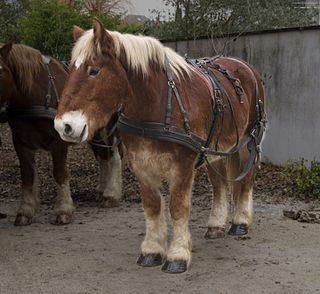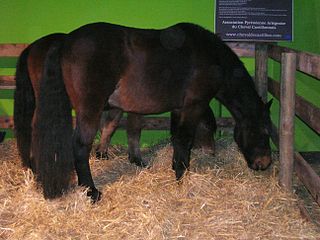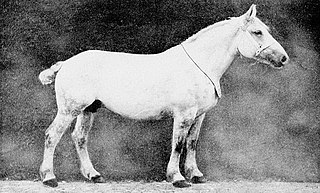
The Camargue, French: Camarguais or Cheval de Camargue, is a traditional French breed of working horse indigenous to the Camargue area in southern France. Its origins are unknown. For centuries, possibly thousands of years, these small horses have lived wild in the harsh environment of the Camargue marshes and wetlands of the Rhône delta, which covers part of the départements of Gard and Bouches-du-Rhône. There they developed the stamina, hardiness and agility for which they are known today. Traditionally, they live in semi-feral conditions in the marshy land of the region. The Camargue horse is the traditional mount of the gardians, the Camargue riders who herd the black Camargue bulls used for courses camarguaises in southern France.

The Trait Breton is a French breed of draught horse. It originated in Brittany, in north-west France, from cross-breeding of local horses with various other breeds. It is strong and muscular, and often has a chestnut coat.

The Auxois is a horse breed from eastern France. It is a large breed, with some individuals weighing over 910 kilograms (2,010 lb), bred for horse meat, agricultural work and leisure pursuits. Overall, members of the breed are solid and muscular in appearance. They are usually bay or bay roan in color, although some other colors are accepted by the breed registry, and are known for their power and docility.

The Trait du Nord, previously also known as Ardennais du Nord or Ardennais de type Nord, is a breed of heavy draft horse developed and bred in the area of Hainaut in western Belgium and in northeastern France. Originally considered a subtype of the Ardennes, it was recognized as an individual breed with the opening of a studbook in 1903. Developed in the fertile Flemish grasslands, it was bred for size and pulling power for agricultural work. By 1855, the horses bred near Hainaut were considered by some veterinarians to be superior to other Flemish draft breeds. The Trait du Nord was used extensively in mining from the late 19th century through 1920, with lesser use continuing through the 1960s.

The Anglo-Norman horse is a warmblood horse breed developed in Lower Normandy in northern France. A major center of horse breeding, the area had numerous regional types that were bred to one another and then crossed with Thoroughbreds to form the Anglo-Norman. Various body types developed within the Anglo-Norman breed, two of which were split off to form the Norman Cob and French Trotter. The remaining types were eventually standardized, although there remained some criticism of the "hybrid" nature of the breed's conformation. However, it is successful as an international sport horse, especially in the sport of show jumping. The Anglo-Norman also contributed to the development of several other breeds in Europe and Asia.

The Provence Donkey, French: Âne de Provence, is a breed of domestic donkey from Provence, in south-eastern France. It is now distributed through much of central and south-east France, with the highest concentration in Provence and the Rhône-Alpes region. For hundreds of years the Provence donkey was used by transhumant shepherds of the area as a pack animal in the seasonal movement of flocks of sheep between their summer pastures on the high Alps of Haute-Provence and the Dauphiné and their winter grounds in Basse-Provence.

The French Trotter is a French breed of trotting horse bred for racing both ridden and in harness. It was bred specifically for racing in the 19th century (1800s), principally in Normandy in north-western France.

The Castillonais or Cheval Ariègeois de Castillon , also formerly called Cheval du Biros or Saint-Gironnais, is an ancient breed of small rustic saddle-horse from the Ariège département of south-western France. It may be dark bay or seal brown. It stands 135–155 centimetres at the withers, with an average height of about 145 cm. It is used principally for trekking and for driving.

The Corse or Corsicana is a French breed of cattle indigenous to the island of Corsica.

The Henson Horse, or Cheval de Henson, is a modern horse breed from northeast France. It was created by the selective breeding of light saddle horses with the smaller, heavier Norwegian Fjord horse to create small horses suitable for the equestrian vacation industry. The breeders' association, Association du Cheval Henson, was formed in 1983. In 1995 the studbook was closed to horses not born from Henson parents, and in 2003 the breed was officially recognised by the French government agencies for horse breeding. A hardy breed of horse, each winter the broodmares and youngstock from several breeders are let loose together to graze freely in the wetland reserves in France.

The Charentais and Vendéen are extinct breeds of horse from western France. They were bred principally in the area around Poitou-Charentes and Vendée, France. They were used as a mount for light cavalry.

The Cotentin Donkey, French: Âne du Cotentin, is a breed of domestic donkey from the Cotentin peninsula, in the département of la Manche, in the Lower Normandy region in north-west France. It is found mostly in that region, but is distributed through much of north-western France. It was in the past used as a pack animal in agricultural work, mainly for carrying milk churns; it is now used in leisure sports and tourism. The breed was recognised by the Ministère de l'Agriculture, the French ministry of agriculture, in 1997. The stud book is kept by the Association de l'âne du Cotentin, an association of breeders.

The Haras Nationaux in France was the French national public administrative body responsible for the regulation and administration of breeding of horses and donkeys in France. It administered twenty-two regional studs, or horse-breeding centres.

The Norman donkey, French: Âne Normand, is a breed of domestic donkey from Normandy, in north-west France. It is found mainly in the present-day Lower Normandy and Upper Normandy regions, and is also present in Brittany and the Pays de Loire. It is the smallest of the seven recognised French donkey breeds. It was formerly used as a pack animal in agricultural work, mainly for carrying milk churns; it is now used in leisure sports and tourism. The breed was recognised by the Ministère de l'Agriculture, the French ministry of agriculture, in 1997. The stud book is kept by the Association de l'Âne Normand, an association of breeders.

The Pyrenean, French: Âne des Pyrénées, is a French breed of domestic donkey. It is distributed in a large area of south-western France, covering the whole of the regions of Aquitaine, Midi Pyrénées and Languedoc Roussillon. The largest concentration is in Aquitaine, which is a large part of the historic region of Gascony. The Pyrenean donkey breed unites two quite different types: the short and powerful Gascon type, and the taller and more elegant Catalan type, which is the French population of the Catalan donkey breed, approximately 20% of the total number of which is in the Roussillon.

The Bourbonnais Donkey, French: Âne bourbonnais, is a breed of domestic donkey from the historic region of the Bourbonnais, which corresponds roughly with the modern département of Allier, in the Auvergne region of central France. It was in the past used as a pack animal, for hauling barges, and to pull light gigs. The breed was recognised by the Ministère de l'Agriculture, the French ministry of agriculture, in 2002. The stud book is kept by the Association de l'Ane Bourbonnais, an association of breeders.

The Grand Noir du Berry, French: Âne grand noir du Berry, is a breed of domestic donkey from the historic region of Berry, in central France. It is particularly associated with the town of Lignières and neighbouring areas of the départements of Cher and Indre. It is found mostly in those départements and in those of Nièvre and Allier, but is distributed through much of central and northern France. It was in the past used both for in agricultural work, particularly in vineyards, and for barge haulage on the canals of the area. The breed was recognised by the Ministère de l'Agriculture, the French ministry of agriculture, in 1994. The stud book is kept by the breeders' association, the Association Française de l'Âne Grand Noir du Berry.

The Corsican Donkey, French: Âne corse, Corsican: U sumeru corsu, is a breed of domestic donkey from the Mediterranean island of Corsica, a région and territorial collectivity of France. It is not recognised by the Ministère de l'agriculture, de l'agroalimentaire et de la forêt, the French ministry of agriculture, or by the Haras Nationaux, the French national stud; nor is it reported to the DAD-IS database of the FAO. Its numbers have fallen alarmingly; two associations are seeking its official recognition as a breed.

The Haras national du Pin is a French national stud located in Le Pin-au-Haras district, in the Orne (61) department of the southern Normandy region. It is the oldest of the French "Haras Nationaux".

The Trait du Maine is an extinct draft horse breed originating from the region of Maine in northwestern France. Bred from the 1830s onwards by crossing mares from Mayenne with Percheron stallions, it had its own studbook due to the Percheron Horse Society refusing to include horses born outside of the Perche region. The Trait du Maine was officially recognized as a horse breed in 1926 and had up to 25,000 annual births in 1929. These horses were mainly exported to the agricultural regions of Beauce, France and Spain. In 1966, the Trait du Maine merged their studbook with the Percheron breed, which absorbed it, leading to the elimination of the Trait du Maine as a distinct breed.




















